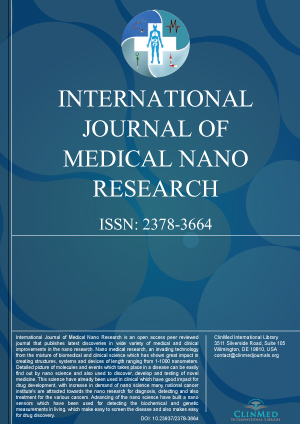Open Access DOI:10.23937/2378-3664/1410005
Development of A Cellular Hepatocarcinoma Animal Model for the Evaluation of Pt(Acac)2/Tio2 Nanoparticles Effect
Tessy Lopez Goerne, Mayra Alvarez Lemus, Gustavo Jardon Guadarrama, Paola Ramirez Olivares, Aurora Sanchez Garcia, Daniel Rembao Bojorquez, Ruben Arguero Sanchez and Octavio Novaro Penalosa
Article Type: Research Article | First Published: December 16, 2014
Because of the worldwide increasing incidence of cancer new alternative therapies are needed. The use of nanotechnology for clinical applications is constantly growing. The objective of this work was to evaluate the effect of the administration of platinum inorganic nanoparticles over livers from Wistar rats. In order to reach this goal cellular Hepatocarcinoma was fist induced with N-nitrosodiethylamine (NDEA) and Carbon tetrachloride....
Open Access DOI:10.23937/2378-3664/1410004
Reliability for Drug Targeting In Cancer Treatment through Nanotechnology (A Psychometric Approach)
Nader Ebrahimi and Ali Mansoori G
Article Type: Research Article | First Published: November 28, 2014
The primary focus of the nanotechnology therapeutic approaches has been on early disease detection, drug discovery and monitoring, controlled release of therapeutic agents, and targeted drug delivery. Targeted drug delivery system requires more research including statistical modelling to establish the reliability in success of drug targeting. This part of every nanotechnology therapeutic approach is especially fundamental for reaching stronger therapeutic effects with lower side effects....
Open Access DOI:10.23937/2378-3664/1410003
Graphene: A Multifaceted Nanomaterial for Cutting Edge Biomedical Application
Reshma S Cherian and Mohanan PV
Article Type: Review Article | First Published: October 27, 2014
Graphene, a discrete class of nanomaterial, has come into the limelight after its discovery in 2004. Its unique physico-chemical characteristics like electrical, optical, thermal properties and high mechanical strength has piqued the curiosity of the scientific community worldwide. These properties have been utilized for innovative and novel applications in the field of nanoelectronics and biomedicine. The review focuses on the opportunities and prospects of graphene in biomedical field mainly d...
Open Access DOI:10.23937/2378-3664/1410002
Anti-Oxidant and Anti-Inflammatory Effects of Vildagliptin in NonAlcoholic Fatty Liver Disease of Mice
Sahar Mohamed Kamal
Article Type: Research Article | First Published: October 13, 2014
Background: Vildagliptin is one of the Dipeptidyl Peptidase-4 (DPP-4) inhibitors. It is used as a novel oral anti-diabetic drug for the treatment of Type 2 Diabetes Mellitus (T2DM) with significant control of glycated hemoglobin and a lower incidence of hypoglycemia or weight gain.
Aim: The present study hypothesized that the DPP-4 inhibitor vildagliptin may exert protective effects on liver in Non-Alcoholic Fatty Liver Disease (NAFLD) in cholesterol-fed albino mice.
Methods: Thirty six albi...
Open Access DOI:10.23937/2378-3664/1410001
Boron Neutron Capture Therapy of Cancer as a Part of Modern Nanomedicine
Alexander V. Safronov
Article Type: Editorial | First Published: August 16, 2014
Boron neutron capture therapy (BNCT) is a method of cancer therapy with a simple idea behind it. Positioning a certain amount of 10B-enriched boron-containing compounds into tumor cells with subsequent irradiation of the tumor tissue by thermal or epithermal neutrons causes tumor damage and death. The mechanism of the tumor cell damage during BNCT is based on the capture-fission reaction between the boron-10 nucleus and a neutron resulting in an α-particle release inside the cell. A success...

